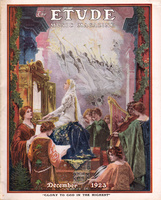Three articles that have appeared lately in The Etude deserve the serious consideration of all of our readers who are concerned in making their piano-playing more beautiful.
They are the articles in the Josef Lhévinne Series, the articles by Kleczynski on “The Study of Chopin” and the interview with Valdimir (sic) De Pachmann in this issue. If you will read between the lines in all of these articles you may discover what might be termed the “Chopin Method” of playing the piano. Chopin would probably rise in his grave at the term; but nevertheless he seemed to have fairly definite ideas upon touch and gave his friends and pupils these ideas.
If the records are representative of Chopin’s real mind, de Pachmann has instinctively adopted the style of playing which the Polish-French master sought in his own work. Lhévinne, working independently and introspectively, has evolved similar principles and insists that upon these good tone at the keyboard largely depends.
One of the first prnciples (sic) is that the blow of the finger upon the key, whether it be from a stroke or from pressure, must be thoroughly cushioned. That is, the part of the finger that touches the key should be as resilient as possible. If we strike the keys on the very tips of the fingers there is a thin hard cushion in comparison with the large ball a little behind the tips. In other words to produce beautiful, mellifluous piano tone we dare not have the finger tips descend upon the keys with a straight line but they must come down in somewhat oblique position, so that a larger and more springing part of the first joint covers the key surface.
Lhévinne insists that the finger move only at the metacarpal joint, that is, the joint where the finger joins the body of the hand.
Your editor, for over a quarter of a century, has been in close personal communication with practically all of the great pianists of the world. He has observed minutely their playing in public and in private, innumerable times. He has noted that those who have been famous for their lovely tone have, either through carefully thought-out principles, or through instinct, played in the manner we have described.
If this simple principle is correct, it will alter the customary methods of elementary instruction very slightly. But this slight change “makes all the difference in the world.” The teacher instead of telling the pupils to play on the finger tips directly behind the finger nails will tell them to play with that broader and softer portion of the first-finger joint. True, this may at first even aggravate that bugbear of all teachers of children, “the collapse of the first joint” but in the long run better results will be obtained. We do not play the piano with claws but with hands.
We feel very strongly, that if these fundamental principles, advocated in the three articles mentioned, are comprehended and broadly applied, much piano playing in America will become vastly more beautiful.
Just one glance at the hands of Mr. Paderewski, shown in the illustration in this issue of The Etude, will serve to confirm everything we have stated in this editorial. Unquestionably the leading performers of the present seek their beautiful singing tone in this manner of hand position.



